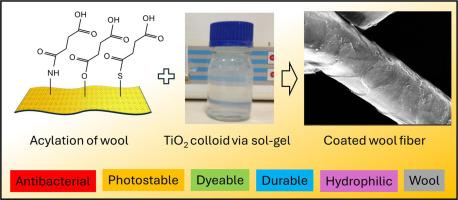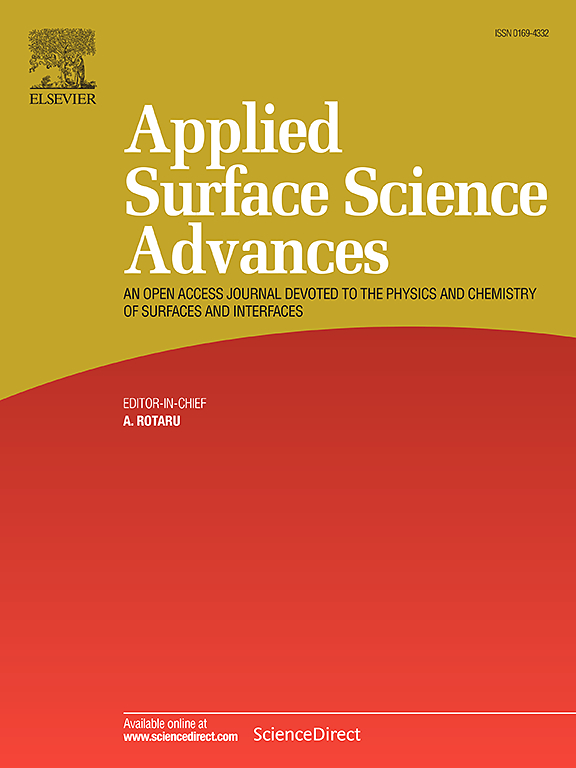Antibacterial wool fabric with enhanced photostability, UV protection and hydrophilicity through surface acylation and TiO2 nanocoating
IF 8.7
Q1 CHEMISTRY, PHYSICAL
引用次数: 0
Abstract
The development of functional textiles through applying nanocoatings has attracted significant attention in recent years. However, poor durability of nanocoatings highlights the necessity of modifying the surface chemistry of fibers to maximize the adherence of nanomaterials. In this study, the surface of wool fibers was modified through the acylation process with succinic anhydride and then post-treatment with anatase TiO2 colloid synthesized via the sol-gel method. Different aspects including the role of wool acylation on fibers chemistry, photostability, UV protection and antibacterial activity against Escherichia coli (E. coli) and Staphylococcus aureus (S. aureus) bacteria were discussed. Furthermore, wetting behavior, light and wash fastness, dyeability, and cytotoxicity of fabrics were investigated, and the role of each coating step was clarified. The findings confirmed that the modified fabric exhibited enhanced photostability under UVA radiation as tested using the photo-induced chemiluminescence (PICL) analysis. The functional fabric provided an excellent UPF level of 140, indicating 37 % improvement compared with pristine wool. The acylated fabric treated with TiO2 colloid was hydrophilic and showed a washing fastness up to five accelerated wash cycles. The existence of TiO2 led to a weaker color strength (K/S) on the dyed fabric, but did not photocatalytically affect the light fastness. The cytotoxicity test did not show any toxic effects on the examined cells viability. Moreover, comprehensive analyses using XPS, FTIR, SEM, and EDX mapping techniques were conducted to characterize the nano-treated fabrics. The outcomes of this research provide new insights on some less explored properties of functionalized textiles, paving the way for real-world applications.

抗菌羊毛织物,通过表面酰化和TiO2纳米涂层增强光稳定性,防紫外线和亲水性
近年来,利用纳米涂层开发功能性纺织品引起了人们的广泛关注。然而,由于纳米涂层耐久性差,因此有必要对纤维的表面化学进行修饰,以最大限度地提高纳米材料的粘附性。本研究首先用琥珀酸酐对羊毛纤维表面进行酰化改性,然后用溶胶-凝胶法合成锐钛矿型TiO2胶体进行后处理。讨论了羊毛酰化在纤维化学、光稳定性、紫外线防护以及对大肠杆菌和金黄色葡萄球菌的抑菌活性等方面的作用。此外,研究了织物的润湿性能、耐光牢度、耐洗牢度、可染性和细胞毒性,并阐明了各涂层步骤的作用。通过光致化学发光(PICL)分析,研究结果证实了改性织物在UVA辐射下表现出增强的光稳定性。这种功能性织物提供了140的UPF水平,与原始羊毛相比提高了37%。经TiO2胶体处理的酰化织物具有亲水性,洗涤牢度可达5次加速洗涤。TiO2的存在导致染色织物的色强(K/S)变弱,但不影响染色织物的光催化牢度。细胞毒性试验未显示对被测细胞活力有任何毒性作用。此外,利用XPS, FTIR, SEM和EDX绘图技术进行了综合分析,以表征纳米处理的织物。本研究的结果为功能化纺织品的一些较少探索的特性提供了新的见解,为现实世界的应用铺平了道路。
本文章由计算机程序翻译,如有差异,请以英文原文为准。
求助全文
约1分钟内获得全文
求助全文

 求助内容:
求助内容: 应助结果提醒方式:
应助结果提醒方式:


